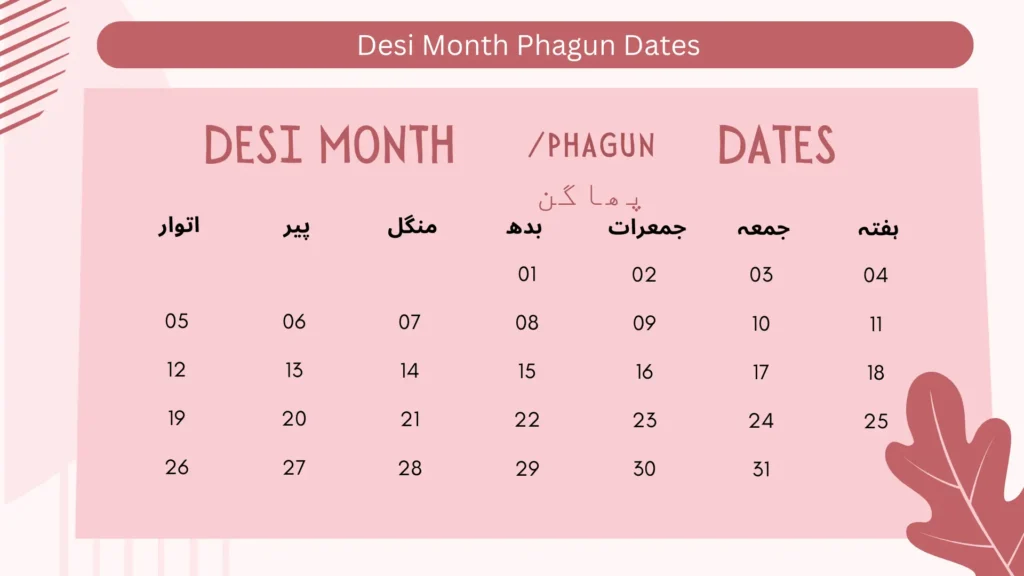Desi Month Phagun Dates 2024 Aligned with English (Gregorian) Dates
You can easily find the dates for the Desi month Phagun in 2024, matched with the English calendar. This helps you keep track of important dates for cultural, religious, or personal reasons. The Phagun dates are shown in both Desi and English formats, and you can even check today’s Desi month date, Sangrand, and Gurpurabs. Additionally, discover other Desi month dates for 2024: Chet, Vaisakhi, Jeth, Harh, Sawan, Badhon, Assu, Katak, Maghar, Poh, and Magh.
The Desi calendar, also known as the Punjabi calendar, is deeply embedded in the cultural and agricultural fabric of the Indian subcontinent. Desi month Phagun, also known as Phalguna, is the twelfth month of this calendar and corresponds to 12 February to 13 March in the Gregorian calendar. This month is marked by the transition from winter to spring, significant agricultural activities, and various festivals celebrated by Muslims, Sikhs, and Hindus. This blog provides a detailed overview of the month of Phagun, its relevance in different calendars, weather patterns, agricultural significance, and cultural festivities.
Introduction to Desi Month Phagun in Various Calendars

- Desi Calendar (Punjabi Calendar): In the Desi calendar, Desi month Phagun represents the end of winter and the beginning of spring. This month is significant for harvesting Rabi crops and celebrating several vital festivals.
- Nanakshahi Calendar: The Nanakshahi calendar, adopted by the Sikh community, modernizes the ancient Bikrami calendar. Phagun in the Nanakshahi calendar aligns with 12 February to 13 March in the Gregorian calendar, encompassing important Sikh observances and celebrations.
- Bikrami Calendar: The Bikrami or Vikram Samvat calendar, an ancient lunar-solar calendar used in India and Nepal, includes Phagun as a significant month. This period is celebrated with traditional Hindu festivals and rituals, reflecting the region’s cultural richness.
Weather During Desi Month Phagun
Desi month Phagun is characterized by the transition from winter to spring, bringing significant changes in weather patterns:
- Temperature: The temperatures during Phagun range from 10°C (50°F) to 20°C (68°F). The days start to become warmer, while the nights remain cool, providing a pleasant climate overall.
- Rainfall: Phagun generally receives minimal rain, but occasional showers can occur, contributing to the end of the winter season and the onset of spring.
- Humidity: Humidity levels rise slightly as the month progresses, but the weather remains relatively dry and crisp overall.
- Agricultural Activities: This month is vital for harvesting Rabi crops and preparing for the next agricultural cycle. The weather conditions are ideal for these activities.
Festivals and Cultural Significance During Desi Month Phagun
Desi month Phagun is a culturally vibrant month with numerous festivals celebrated by Muslims, Sikhs, and Hindus. These festivals are deeply embedded in religious traditions and seasonal cycles.
- Muslim Festivals:
- Shab-e-Miraj: Depending on the lunar calendar, Shab-e-Miraj, commemorating Prophet Muhammad’s night journey to heaven, may fall in Phagun. It is observed with prayers and sermons.
- Sikh Festivals:
- Hola Mohalla: This festival is celebrated a day after Holi and involves martial arts displays, mock battles, kirtans (devotional songs), and langars (community meals). Guru Gobind Singh Ji started it to demonstrate Sikh military preparedness and valor.
- Shaheedi of Guru Arjan Dev Ji: The martyrdom of the fifth Sikh Guru, Guru Arjan Dev Ji, is observed with special prayers and kirtans in Gurdwaras.
- Hindu Festivals:
- Maha Shivaratri: This festival is dedicated to Lord Shiva and involves night-long vigils, fasting, and special prayers. Devotees visit Shiva temples and offer the deity milk, fruits, and bel leaves.
- Holi: Known as the festival of colors, Holi is celebrated enthusiastically. It marks the arrival of spring and involves throwing colored powders, singing, dancing, and festive meals. It symbolizes the victory of good over evil and the end of winter.
Agricultural Importance of Desi Month Phagun
The month of Phagun is significant for agriculture in the Indian subcontinent. Here are some critical aspects of its agricultural importance:
- Harvesting Rabi Crops: Phagun is crucial for the harvesting of Rabi crops such as wheat, barley, mustard, and peas. The dry and calm weather is ideal for harvesting and storing these crops.
- Soil Preparation for the Next Cycle: Farmers start preparing the soil for the following agricultural cycle, which includes plowing, leveling, and adding organic matter to enrich the soil.
- Water Management: Effective water management practices are essential during Phagun to ensure adequate moisture for harvested crops and prepare the fields for the next planting season.
- Pest and Disease Control: This month, farmers are vigilant about controlling pests and diseases to protect their crops and ensure a healthy harvest.
Traditional Practices and Rituals During Desi Month Phagun
Desi month Phagun is rich in traditional practices and rituals that reflect the region’s cultural heritage and agricultural cycles. These practices are often intertwined with religious beliefs and seasonal changes:
- Religious Observances: Special prayers, fasting, and rituals are expected during the various festivals in Phagun. These practices seek divine blessings for prosperity, health, and good harvests.
- Folk Songs and Dances: Phagun’s cultural vibrancy is reflected in folk songs and dances that celebrate the end of winter, the arrival of spring, agricultural activities, and festivals. These performances are an integral part of community gatherings and celebrations.
- Ritual Offerings: Farmers and families make offerings to deities and nature spirits, seeking protection and blessings for their crops and households. These offerings often include grains, fruits, and flowers.
- Community Feasts: Festivals during Phagun often accompany communal meals, where families and communities share food and celebrate. These feasts strengthen social bonds and promote a sense of unity.
Conclusion
The Desi month of Phagun, which lasts from 12 February to 13 March, is a period of great cultural, religious, and agricultural significance in the Indian subcontinent. It marks the transition from winter to spring, bringing pleasant weather ideal for harvesting Rabi crops and continuing various farming activities.
Festivals such as Shab-e-Miraj, Hola Mohalla, Maha Shivaratri, and Holi bring communities together in celebration, reflecting the region’s rich cultural diversity. Traditional practices and rituals during Phagun highlight the deep connection between nature, agriculture, and religion, showcasing the people’s resilience and adaptability.
Understanding the significance of Phagun helps us appreciate the intricate relationship between the natural cycles of the earth and the cultural practices of communities. As we delve into the rhythms of this desi month, we gain insights into the vibrant and dynamic traditions that have sustained and enriched the lives of people in the Indian subcontinent for centuries.
